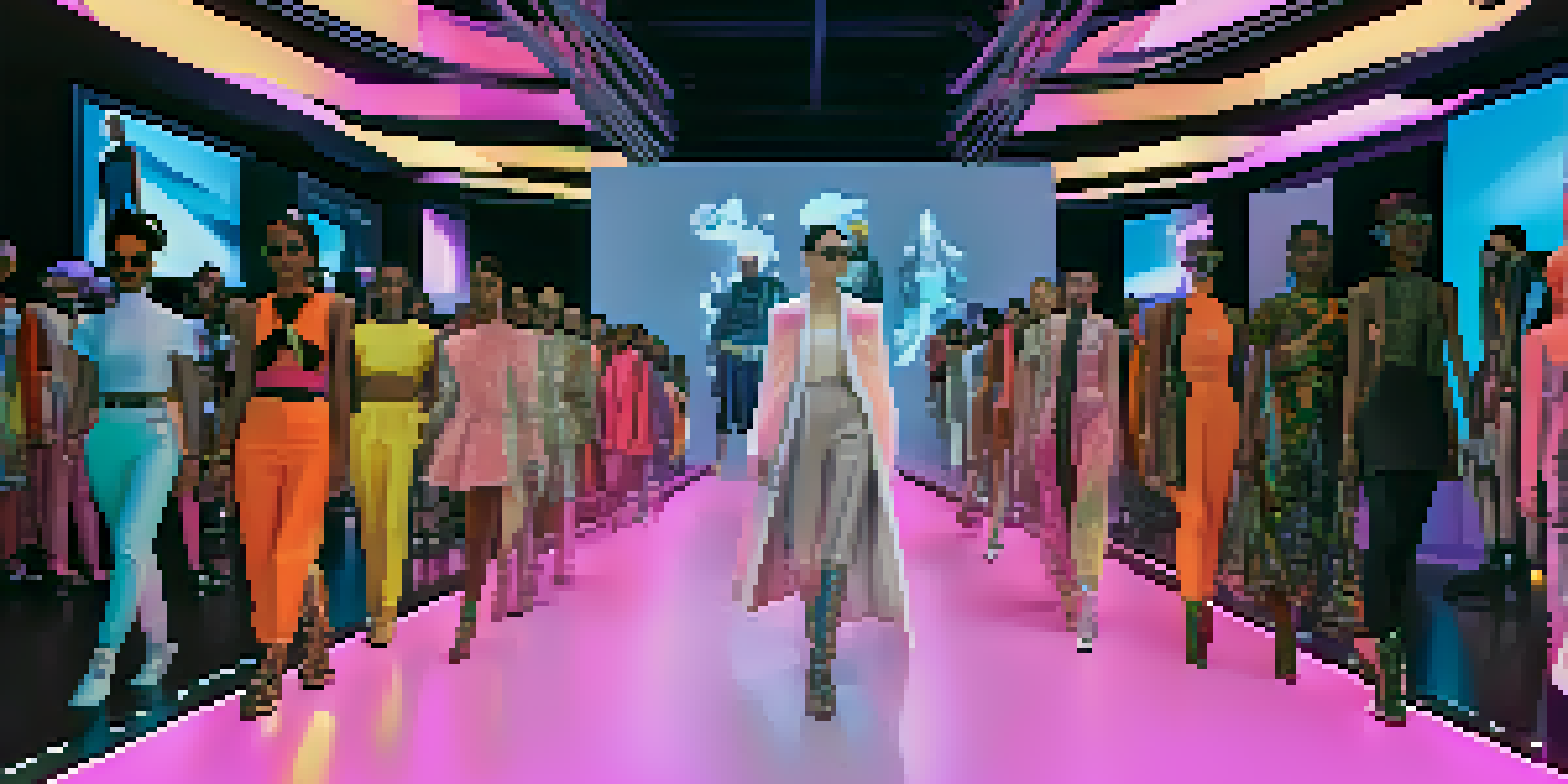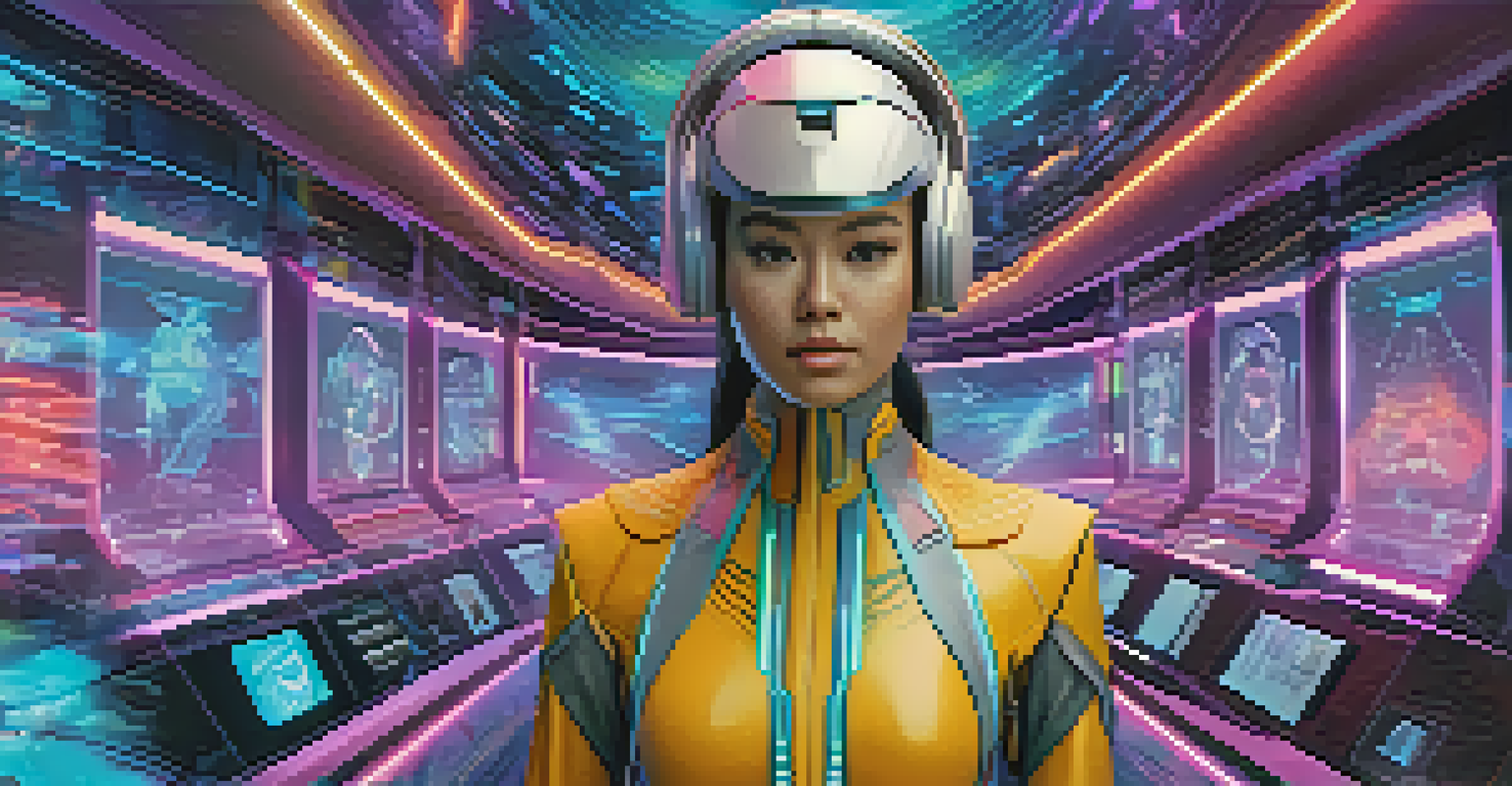Understanding Virtual Fashion: NFTs and Digital Avatars

What is Virtual Fashion and Why Does It Matter?
Virtual fashion refers to clothing and accessories designed for digital environments, such as video games or social media platforms. It's a growing trend that allows individuals to express their style online without the environmental impact of traditional fashion. In a world increasingly dominated by digital interactions, virtual fashion is becoming a significant part of personal identity.
Fashion is the armor to survive the reality of everyday life.
Imagine dressing your avatar in unique outfits that reflect your personality, just like you would in real life. This concept not only enhances the virtual experience but also opens doors for creativity and self-expression. As people spend more time online, the importance of looking good in digital spaces can't be overstated.
Moreover, virtual fashion can democratize style, allowing anyone with internet access to experiment with looks that may be unaffordable or impractical in reality. It empowers users to showcase their creativity and individuality in ways that traditional fashion can sometimes limit.
The Role of NFTs in Virtual Fashion
NFTs, or Non-Fungible Tokens, are digital assets that represent ownership of unique items on the blockchain. In the realm of virtual fashion, NFTs allow designers to sell exclusive digital clothing or accessories, creating scarcity and value. This is akin to owning a one-of-a-kind painting in the art world, but in a digital format.

When a user buys an NFT outfit for their avatar, they gain not just a piece of virtual clothing but also proof of ownership. This ownership can sometimes appreciate in value, making virtual fashion a new frontier for collectors and fashion enthusiasts alike. It's an exciting intersection of technology and style that’s reshaping the fashion landscape.
NFTs Create Value in Digital Fashion
NFTs empower designers to sell unique digital outfits, establishing ownership and potential value appreciation in the virtual fashion landscape.
Additionally, NFTs can also enable designers to receive royalties every time their creations are resold, providing ongoing financial benefits. This innovative revenue model empowers creators and encourages them to produce high-quality, desirable digital fashion items.
How Digital Avatars are Changing Personal Expression
Digital avatars serve as our online representatives, and how we dress them is a reflection of who we are. With the ability to customize avatars in endless ways, users can experiment with styles they may not dare to try in real life. This freedom of expression is particularly appealing in a society that often imposes rigid fashion norms.
The future belongs to those who believe in the beauty of their dreams.
For instance, an individual might choose a bold, avant-garde outfit for their avatar that they wouldn't wear on the street. This allows for a playful exploration of identity, where people can embrace aspects of themselves that remain hidden in the physical world. The customization options available today are practically limitless, enhancing the overall online experience.
Moreover, as social interactions increasingly happen in virtual spaces, the way we dress our avatars can influence perceptions and interactions with others. This adds an exciting layer to online relationships, where fashion choices can convey personality traits and moods.
The Environmental Impact of Virtual Fashion
One of the most appealing aspects of virtual fashion is its potential to reduce the environmental footprint of traditional fashion. The fashion industry is notorious for its waste and pollution, while digital clothing has a minimal ecological impact. By shifting some of our fashion consumption to the virtual space, we can potentially lessen the burden on our planet.
Consider this: creating a single physical garment requires resources like water, energy, and raw materials, contributing to significant environmental degradation. In contrast, virtual fashion eliminates these concerns, allowing us to enjoy style without the guilt associated with fast fashion.
Sustainable Shift to Digital Fashion
By embracing virtual fashion, we can reduce the environmental footprint of the clothing industry while exploring innovative styles.
However, it's essential to remain mindful of the energy consumption associated with blockchain technology and digital transactions. As the industry grows, finding sustainable practices for NFT creation and storage will be crucial to ensure that virtual fashion remains an eco-friendly alternative.
The Future of Fashion: Blending Virtual and Reality
As technology advances, the lines between virtual and real-world fashion are beginning to blur. Brands are increasingly experimenting with augmented reality (AR) and virtual reality (VR) to create immersive shopping experiences. Imagine trying on a digital outfit in a virtual store before purchasing it for your avatar or even for yourself in real life.
This fusion of the digital and physical worlds opens exciting possibilities for consumers and designers alike. It allows for a more interactive and personalized shopping experience, making the process of selecting outfits more engaging. The integration of AR in fashion shows and retail spaces is just the beginning of this trend.
In the coming years, we may see more collaborations between traditional fashion brands and digital creators. This partnership could lead to groundbreaking designs that exist in both realms, pushing the boundaries of fashion as we know it. The future is bright, and the potential for innovation in this space seems limitless.
Challenges Facing Virtual Fashion Today
Despite its potential, virtual fashion faces several challenges that need addressing. One major issue is the perception of value; many consumers may not see digital clothing as worth the investment compared to physical garments. Educating users about the benefits and uniqueness of virtual fashion is crucial for its growth.
Additionally, the technology required for creating and using NFTs can be daunting for some. Navigating blockchain platforms and digital wallets might feel overwhelming for those new to the space. Simplifying these processes and providing clear guidance will help more people engage with virtual fashion.
Virtual Fashion Enhances Self-Expression
Virtual fashion allows individuals to creatively express their style online without the environmental impact of traditional clothing.
Lastly, the lack of standardization in digital fashion can lead to inconsistencies in quality and user experience. As the industry matures, establishing guidelines and best practices will be essential to ensure a cohesive and enjoyable experience for everyone involved.
Conclusion: Embracing the Digital Fashion Revolution
In conclusion, virtual fashion, powered by NFTs and digital avatars, is reshaping how we think about style and self-expression. As we continue to explore this exciting frontier, it's important to remain open to the possibilities it presents. From unique digital wardrobes to eco-friendly alternatives, the benefits are vast.
As technology evolves, so too will our understanding of fashion and its role in our lives. Embracing this new paradigm can lead to innovative approaches to personal style and creativity. The future of fashion is undoubtedly digital, and it’s time to dive in.

So whether you’re a fashion enthusiast, a tech lover, or simply curious about the digital world, now is the perfect moment to explore virtual fashion. Who knows? You might just find a new way to express yourself in the most unexpected of places.